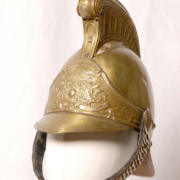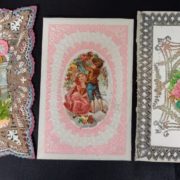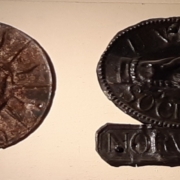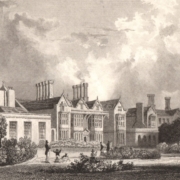Coats of Many Colours: A brief history of fire-fighting uniform
When the early fire office and insurance company brigades were formed they introduced very colourful uniforms so that they could be easily identified.
By the 19th century there were so many different brigades in operation: insurance, volunteer, parish, institutional, estate, industrial, as well as combined police-fire brigades, it was almost impossible to have any standardisation in uniforms at all. Some wore tight woollen tunics over velvet-like breeches, with leather helmets. Others wore sombre grey trouser suits. Some of the London brigades even adopted naval fashions, wearing low top hats (beavers), white canvas trousers and short double-breasted tunics, similar to a naval midshipman’s jacket.
The Metropolitan brigade were different again, adopting blue double-breasted tunics with stout waterproof trousers and Napoleon style leather boots, which were cut higher at the front for added knee protection. Brass helmets began to be more commonly worn, which had raised peaks and broad protective neckpieces for added protection. Higher ranking officers tended to wear silver coloured helmets, as well as gilt badges, gold braiding and shoulder epaulettes to denote their higher status.
Brass helmet, late 19th century worn by the Saffron Walden Volunteer Fire Brigade – adapted French Pattern style made by Merryweather
In the run up to the Second World War, as part of Air Raid Precautions most brigades swapped their brass helmets for cork ones and wore rubber boots, to reduce their chances of electrocution. By 1939, however these had been changed for steel “battle-bowler” helmets which could be easily and cheaply mass produced. They could also be boiled unlike the cork ones, which was crucial at a time when people feared blister gas attacks. Auxiliary Fire Service (AFS) volunteers were generally provided with peaked caps, overalls, rubber boots and a helmet. Officers in the AFS tended to wear white helmets with red markings denoting their rank. Regular brigades had two working uniforms, whilst the AFS had to struggle along with one, so they were often forced to clean equipment at their stations in their long-johns whilst their uniforms’ dried out!
The fire brigades were nationalised in 1941 for the duration of the Second World War and with this came more standardised uniforms. Lower ranks wore a fire tunic for all occasions, whilst officers had a dark blue undress uniform, as well as a fire tunic with rank markings on the shoulders.
When the fire services denationalised in 1948, 140 fire authorities were created (compared to the 1440 authorities that had existed pre-war). Post-war uniforms incorporated major technological improvements in fabrics, which reflected that the brigades were now tackling more hazardous situations, such as industrial accidents and complex road traffic accidents. Naval style pullovers were introduced for more informal occasions and firemen’s helmets began to be painted canary yellow, with officer’s ones remaining white but with black rank bands. In the 1980s fluorescent anoraks with reflective strips and Velcro fasteners were introduced.
Breathing apparatus was first introduced in 1875. Early versions featured manually operated air pumps and the firefighter was attached to a lifeline tube, so it wouldn’t have been that flexible for moving around but was vital to keep them alive. Self-contained oxygen supply systems existed in 1881, but they weren’t widely adopted until after the First World War. Fire resistant asbestos suits, hoods, gloves and aprons used in the 1920s have been replaced with safer and more effective epoxy coated aluminium fibres and materials that utilise complex fire resistant and retardant chemicals. Fire-fighters uniforms continue to adapt regularly to take account of fashion as well as the challenging environments that they face.









